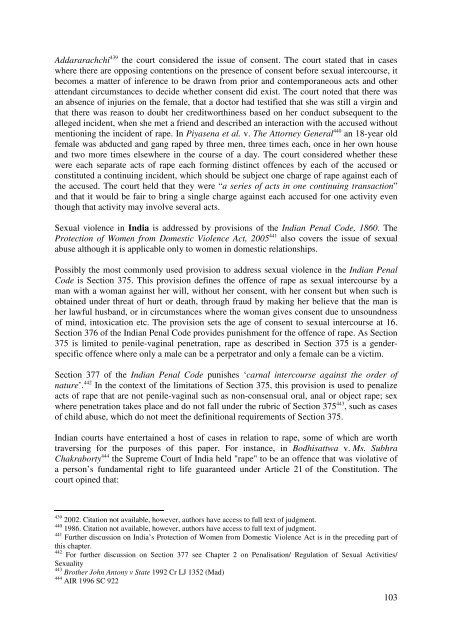SEXUAL HEALTH AND HUMAN RIGHTS A legal and ... - The ICHRP
SEXUAL HEALTH AND HUMAN RIGHTS A legal and ... - The ICHRP
SEXUAL HEALTH AND HUMAN RIGHTS A legal and ... - The ICHRP
Create successful ePaper yourself
Turn your PDF publications into a flip-book with our unique Google optimized e-Paper software.
Addararachchi 439 the court considered the issue of consent. <strong>The</strong> court stated that in cases<br />
where there are opposing contentions on the presence of consent before sexual intercourse, it<br />
becomes a matter of inference to be drawn from prior <strong>and</strong> contemporaneous acts <strong>and</strong> other<br />
attendant circumstances to decide whether consent did exist. <strong>The</strong> court noted that there was<br />
an absence of injuries on the female, that a doctor had testified that she was still a virgin <strong>and</strong><br />
that there was reason to doubt her creditworthiness based on her conduct subsequent to the<br />
alleged incident, when she met a friend <strong>and</strong> described an interaction with the accused without<br />
mentioning the incident of rape. In Piyasena et al. v. <strong>The</strong> Attorney General 440 an 18-year old<br />
female was abducted <strong>and</strong> gang raped by three men, three times each, once in her own house<br />
<strong>and</strong> two more times elsewhere in the course of a day. <strong>The</strong> court considered whether these<br />
were each separate acts of rape each forming distinct offences by each of the accused or<br />
constituted a continuing incident, which should be subject one charge of rape against each of<br />
the accused. <strong>The</strong> court held that they were “a series of acts in one continuing transaction”<br />
<strong>and</strong> that it would be fair to bring a single charge against each accused for one activity even<br />
though that activity may involve several acts.<br />
Sexual violence in India is addressed by provisions of the Indian Penal Code, 1860. <strong>The</strong><br />
Protection of Women from Domestic Violence Act, 2005 441 also covers the issue of sexual<br />
abuse although it is applicable only to women in domestic relationships.<br />
Possibly the most commonly used provision to address sexual violence in the Indian Penal<br />
Code is Section 375. This provision defines the offence of rape as sexual intercourse by a<br />
man with a woman against her will, without her consent, with her consent but when such is<br />
obtained under threat of hurt or death, through fraud by making her believe that the man is<br />
her lawful husb<strong>and</strong>, or in circumstances where the woman gives consent due to unsoundness<br />
of mind, intoxication etc. <strong>The</strong> provision sets the age of consent to sexual intercourse at 16.<br />
Section 376 of the Indian Penal Code provides punishment for the offence of rape. As Section<br />
375 is limited to penile-vaginal penetration, rape as described in Section 375 is a genderspecific<br />
offence where only a male can be a perpetrator <strong>and</strong> only a female can be a victim.<br />
Section 377 of the Indian Penal Code punishes ‘carnal intercourse against the order of<br />
nature’. 442 In the context of the limitations of Section 375, this provision is used to penalize<br />
acts of rape that are not penile-vaginal such as non-consensual oral, anal or object rape; sex<br />
where penetration takes place <strong>and</strong> do not fall under the rubric of Section 375 443 , such as cases<br />
of child abuse, which do not meet the definitional requirements of Section 375.<br />
Indian courts have entertained a host of cases in relation to rape, some of which are worth<br />
traversing for the purposes of this paper. For instance, in Bodhisattwa v. Ms. Subhra<br />
Chakraborty 444 the Supreme Court of India held "rape" to be an offence that was violative of<br />
a person’s fundamental right to life guaranteed under Article 21 of the Constitution. <strong>The</strong><br />
court opined that:<br />
439 2002. Citation not available, however, authors have access to full text of judgment.<br />
440 1986. Citation not available, however, authors have access to full text of judgment.<br />
441 Further discussion on India’s Protection of Women from Domestic Violence Act is in the preceding part of<br />
this chapter.<br />
442 For further discussion on Section 377 see Chapter 2 on Penalisation/ Regulation of Sexual Activities/<br />
Sexuality<br />
443 Brother John Antony v State 1992 Cr LJ 1352 (Mad)<br />
444 AIR 1996 SC 922<br />
103

















